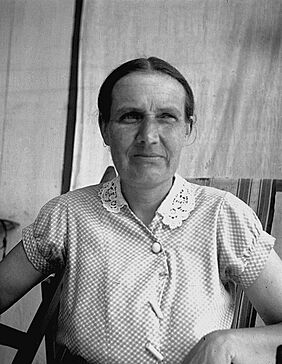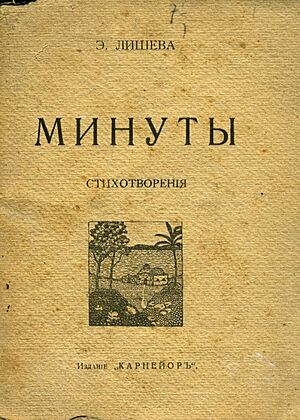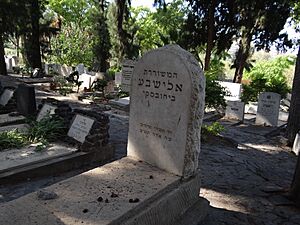Elisheva Bikhovski facts for kids
Quick facts for kids
Elisheva Bikhovski
Елишева Биховски |
|
|---|---|

Elisheva Bikhovski in Israel – 1936
|
|
| Native name |
ז'ירקובה-ביחוֹבסקי ,אלישבע
|
| Born | Elizaveta Ivanovna Zhirkov 20 September 1888 Spassk, Ryazan, Russia |
| Died | 27 March 1949 (aged 60) Tiberias, Israel |
| Resting place | Kvutzat Kinneret cemetery |
| Pen name | E. Lisheva |
| Occupation | writer, translator |
| Language | Hebrew, Russian, English, Yiddish |
| Citizenship | Russian Empire, Israel |
| Years active | 1907 to 1949 |
| Spouse | Simeon (Shimon) Bikhovski |
| Children | Miriam Littel |
Elisheva Bikhovski (born Elizaveta Ivanovna Zhirkov, 1888–1949) was a talented writer and poet from Russia. She was also a literary critic and translator. Many people knew her by her Hebrew name, "Elishéva." Elisheva wrote most of her books and poems in Hebrew, which is interesting because her family was Russian Orthodox and Irish Catholic, not Jewish. She also translated English and Hebrew poems into Russian.
When Elisheva's mother passed away in 1891, she moved to Moscow to live with her aunt. There, she grew up surrounded by English language and culture. Even though she wasn't Jewish, she became friends with Jewish girls at school. They taught her about their culture and traditions. She started writing poetry in 1907.
At first, she didn't know the difference between Hebrew and Yiddish, thinking they were both just "Jewish languages." She began studying Yiddish, which she found easy to learn because it was similar to other European languages like German. She learned the Hebrew alphabet from a grammar book owned by her brother, Lev Zhirkov, who studied languages. Elisheva studied both Russian and English literature. In 1910, she became a certified teacher for young children.
Contents
Learning Hebrew: A Unique Journey
Discovering Hebrew in Russia
Elisheva remembered being interested in different places from adventure books when she was young. Her interest in Hebrew started when she found a Hebrew newspaper. She saw an advertisement for a steamship company that could take people across the Atlantic Ocean. At that time, Galveston, Texas was a big port for European travelers going to the United States.
With the help of a German textbook for learning Biblical Hebrew, she slowly figured out the name Galveston. Then she could understand other city names like London, Saint Petersburg, and Berlin that were listed in the newspaper. However, she couldn't understand anything else in the paper. Eventually, someone explained to her that there were two different "Jewish" languages. They were both written with the same letters but had very different words and grammar.
In 1913, Elisheva began taking evening classes to learn Hebrew. These classes were part of a group called the "Society for the dissemination of correct information about Jews and Judaism." This group was started by Jewish public figures in Moscow, including her future husband, Simeon Bikhovski. Her first teacher taught Hebrew by speaking only Hebrew, without using a textbook.
She said, "From the first lesson, I knew only two Hebrew words, but I was sure I knew them correctly. I knew what it meant when the teacher asked, 'Do you understand?' I hadn't even seen the Hebrew letters yet, only heard the sounds. But this knowledge was strong and thorough."
This teacher was popular, but he had to leave Moscow because he didn't have the right papers to live there. Elisheva still continued to learn Hebrew on and off for the next two years.
Continuing Hebrew Studies in the Soviet Era
After her father died in 1917, Elisheva went back to her hometown of Ryazan. She saw street demonstrations celebrating freedom, which had been forbidden before. In one protest, she marched with a group of Jewish young people, singing Hatikvah, which later became Israel’s national anthem.
In Ryazan, she found another Hebrew teacher. He was very young but had a long black beard. Elisheva said he had "a love for old biblical stories mixed with a childlike innocence." She showed him she could read a Jewish prayer book. He agreed to help her continue her Hebrew studies. However, he often talked about social and political issues, so their language lessons didn't last long.
She tried to study on her own using a book, but she found it old-fashioned and confusing. Later, she found another teacher. But neither of them had good textbooks. Even though he had taught for many years, he had never taught Hebrew by speaking only Hebrew.
From 1918 to 1919, she studied with a young Hebrew teacher who had visited Russia from Jaffa, a city in what would become the British Mandate for Palestine. This teacher spoke Hebrew with the Sephardic pronunciation, which was preferred by Eliezer Ben Yehuda, who helped bring modern Hebrew back to life. Elisheva said, "Before then, none of my teachers had thought it was possible to have a conversation in Hebrew."
Elisheva's Writing Career
Elisheva started her writing career in 1915. Her first translations from Yiddish into Russian were published in a Jewish magazine called Evreskaya Zhizn ("Jewish Life"). She translated short stories and poems. Later, she began translating works by modern Hebrew writers.
Between 1917 and 1919, while in Ryazan, her Hebrew skills grew stronger. She wrote over 200 Russian poems. Her fiancé, Simeon Bikhovski, published them in two collections in 1919: Minuty ("Minutes") and Tainye Pesni ("Secret songs"). Both were published under her pen name "E. Lisheva." These poems showed her deep connection to Jewish culture.
In 1920, she married Simeon Bikhovski. She published her first poems in Hebrew and officially started using the name Elisheva instead of Elizaveta. She decided to write only in Hebrew from then on. Her husband also changed his name to the Hebrew form, Shimon. They had a civil wedding because their different religions meant they couldn't have a religious one.
Elisheva's poetry appeared in several magazines and almanacs around the world. In 1925, the Bikhovskis moved to Palestine with their young daughter, Miriam (born 1924). They settled near the Herzliya Hebrew Gymnasium in Jaffa. There, she published two poetry collections: Kos ktana ("Small Bowl," 1926) and Haruzim ("Rhymes," 1928). Her use of Sephardic pronunciation in her poetry became the accepted way to speak Hebrew.
As one of Palestine's first Hebrew poets, Elisheva helped shape the new country's literary scene. She explained that her main goal was "to help Hebrew poetry grow in the Hebrew language that we speak every day." She wanted Hebrew poetry to be "vital, natural, and linked to our language and our lives."
People were very touched that Elisheva, who was not Jewish, had left her home and language to join the Jewish people in Palestine. The literary community welcomed her warmly. Her works were widely published, and she became very popular. Her book Kos Ketanah was the first book of poems by a woman poet in Palestine. Simta’ot was the first novel by a woman published there. Some of her beautiful poems have even been set to music.
Later Life and Legacy
Elisheva and her husband often faced challenges earning money. She sometimes had to leave her family to go on literary tours in Europe. She would read her poetry and tell stories to large audiences. During summer school breaks, her husband and daughter would join her.
In the summer of 1932, while on a tour in Chișinău, her husband Shimon suddenly passed away. Elisheva returned to Tel Aviv, heartbroken. She tried to find work, including as a librarian, but it was difficult. Even though her tours had helped them financially before, she and her daughter now faced poverty.
She moved into a small, old shack in Tel Aviv. The famous poet Hayim Nahman Bialik helped her get a small monthly payment from a foundation that supported Hebrew writers.
Elisheva became sad and felt less appreciated by the literary community in Palestine. She stopped publishing new works and kept to herself. She did some translations, but she didn't think they were very important. She even had to work as a laundress to make ends meet.
Her daughter, Miriam Littel, served in the British army in Egypt during World War II. In 1946, Miriam married a British soldier and had three daughters. In 1949, Elisheva planned to visit them in England. However, she wasn't feeling well. Friends from a women's magazine paid for her to visit the hot springs in Tiberias. She passed away there from cancer on March 27, 1949.
Elisheva deeply loved Jewish culture and supported the creation of the state of Israel. But she never converted to Judaism; she always remained an Orthodox Christian. Because of this, there were questions about where she should be buried. Finally, with help from the chairman of the Hebrew Writers Association in Israel, it was agreed that she could be buried in the cemetery of Kvutzat Kinneret, near the grave of another poet, Rachel Bluwstein.
Books Published in Hebrew
- 1926: Kos Ketanah (“A little cup”), poetry
- 1926: Im Or Boker Be-Kol Rinah (“With morning light and a joyful song”), poetry
- 1928: Haruzim (“Rhymes”), poetry
- 1928: Sipurim (“Stories”), short stories
- 1929: Simta’ot (“Alleys”), novel
- 1929: Mikreh Tafel (“A minor incident”), story
- 1946: Shirim, (“Poems”)
- 1970: Yalkut shirim (“Collected poems”)
Sources
- Arnon, Yochanan. “Our Sister Elisheva.” Et Mol (July 1978): 41–42.
- Barzel, Hillel. Elisheva and Her Novel Simta’ot. Tel Aviv: 1977, 280–298.
- Berlovitz, Yaffah. “Ruth from the Banks of the Volga.” Maariv Literary Supplement, 8 June 2000, 27. Berlovitz, Yaffah. “Round and Round the Garden: Mikreh Tafel and Five Other Stories.” Davar, 22 April 1977, 16.
- Elisheva, From My Memoirs. Elisheva Archives, Genazim (7863/5), Saul Tchernichowsky House, Tel Aviv
- Elisheva: The Collected Poems, with an introduction by Haim Toren. Tel Aviv: 1970, 9–16.
- Elisheva: Collected Articles about the Poet Elisheva. Warsaw and Tel Aviv: 1927.
- Kornhendler, Shulamit. “The Principle of Expansion of the Genre in the Work of Elisheva” Hebrew-language Master's thesis, Bar-Ilan University, 1999.
- Meron, Dan. Founding Mothers, Stepsisters. Tel Aviv: 1991, 25–33, 103–104, 154–155.
- Rattok, Lily, ed. “Every Woman Knows It: An Afterword,” in The Other Voice: Hebrew Women’s Literature. Tel Aviv: 1994, 268–269, 336–337.
- Rav-Hon, Orna. “The Confessional Model in the Work of Elisheva.” Master's thesis, Tel Aviv University, 1989.
- Shaked, Gershon. “Elisheva Bikhovsky (Zhirkova).” Hebrew Literature, 1880–1980, vol. 3, 87–93. Tel Aviv/Jerusalem: 1988.



